About
Amputees can do anything and everything
- Home
- About
- Latest news
- Amputees can do anything and everything
The Royal Talbot Orthotics and Prosthetics Department is incredibly busy, fitting approximately 100 limbs per year to ensure patients can lead fulfilled lives.
The team designs, manufactures, fits and maintains all types of functional limb prosthetics, including lower limb prostheses ranging from partial foot silicone restorations, to replacement of the full leg including hip, knee and ankle joints.
“About 70 per cent of prostheses manufactured are for amputation between the knee and the ankle,” Senior Prosthetist, Jason Semple, says.
“The reasons for limb deficiency include congenital malformation, traffic or workplace accidents and cancer, however, most clients we see experience limb loss because of vascular disease, usually secondary to diabetes.”
The manufacturing time depends on the type of device required, but typically varies from 16 to 45 hours of clinical and technical work per device.
Patients are initially seen by a multidisciplinary team to discuss and evaluate their individual circumstances and whether they will be able to a prosthesis effectively.
If approved, the parts are ordered and an appointment is made to commence the manufacturing process.
Measurements and a plaster impression of the residual limb are recorded at the first appointment, and at the initial fitting, any adjustments to the fit and length and alignment are made.
Once the patient and prosthetist are happy at the trial fitting, the final prosthetic is then manufactured.
“When fitted with a prosthesis for the first time, most patients are a little anxious but also looking forward to being able to get up and walk,” Jason says.
“Over time we see their anxiety settle down and replaced by relief mixed with a resolve to get up and do things. Every individual is different.
“Seeing people achieve things they didn't think they could is always a really good feeling. Without a doubt it is the reason why most of us are in this industry.”
It’s National Amputee Awareness Week and Jason wants to remind the community that amputees are no different to anyone able bodied.
“Amputees can do anything and everything they want to do – thanks to the NDIS, amputees now have access to the best technology available worldwide and the limitations they once experienced on a day to day basis, are becoming less apparent,” he says.


